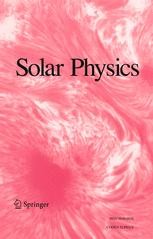Editors' Choice: "Analysis of Large Deflections of Prominence–CME Events during the Rising Phase of Solar Cycle 24"
 Sieyra, M.V., Cécere, M., Cremades, H. et al. Analysis of Large Deflections of Prominence–CME Events during the Rising Phase of Solar Cycle 24. Sol Phys 295, 126 (2020). https://doi.org/10.1007/s11207-020-01694-0
Sieyra, M.V., Cécere, M., Cremades, H. et al. Analysis of Large Deflections of Prominence–CME Events during the Rising Phase of Solar Cycle 24. Sol Phys 295, 126 (2020). https://doi.org/10.1007/s11207-020-01694-0
Editor's Choice (Research Article)
Published: 09 September 2020
Topical Collection: PROBA-2 at Ten Years
"This is an excellent paper, presenting a detailed analysis of the deflection CMEs and associated prominences and the relation of the deflection to the magnetic energy density. This study is broader and deeper than any previous analysis, analyzing in thirteen CMEs and their associated prominences seen by at least two spacecraft. This paper is clearly the result of an enormous amount of careful, time-consuming data analysis and the authors are to be congratulated on their perseverance." [anonymous reviewer]
Abstract:
The analysis of the deflection of coronal mass ejection (CME) events plays an important role in the improvement of the forecasting of their geo-effectiveness. Motivated by the scarcity of comprehensive studies of CME events with a focus on the governing conditions that drive deflections during their early stages, we performed an extensive analysis of 13 CME events that exhibited large deflections during their early development in the low corona. The study was carried out by exploiting solar-corona-imaging observations at different heights and wavelengths from instruments onboard several space- and ground-based solar observatories, namely the Project for Onboard Autonomy 2 (PROBA2), Solar Dynamics Observatory (SDO), Solar TErrestrial RElations Observatory (STEREO), Solar and Heliospheric Observatory (SOHO) spacecraft, and from the National Solar Observatory (NSO). The selected events were observed between October 2010 and September 2011, to take advantage of the location in near quadrature of the STEREO spacecraft and Earth in this time period. In particular, we determined the 3D trajectory of the front envelope of the CMEs and their associated prominences with respect to their solar sources by means of a forward-modeling and tie-pointing tool, respectively. By using a potential-field source-surface model, we estimated the coronal magnetic fields of the ambient medium through which the events propagate to investigate the role of the magnetic-energy distribution in the non-radial propagation of both structures (front envelope and prominence) and in their kinematic properties. The ambient magnetic environment during the eruption and early stages of the events is found to be crucial in determining the trajectory of the CME events, in agreement with previous reports.
Solar Physics Editor's Choice:
In each volume of Solar Physics, a few articles are marked as “Editors’ Choice”. The primary criteria is original, high quality research that is of wide interest within the community.
